The NUMEN Project: Toward New Experiments with High-Intensity Beams
Abstract
1. Introduction
- –
- Parent/daughter states of the 0νββ decay are the same as those of the target/residual nuclei in the DCE.
- –
- Short-range Fermi, Gamow–Teller, and rank-2 tensor components are present in both transition operators, with relative weight depending on incident energy in the DCE. Performing the DCE experiments at different bombarding energies is essential to gaining sensitivity on the individual contribution of each component.
- –
- A large linear momentum (≈100 MeV/c) is available in the virtual intermediate channel of both processes. This is a distinctive similarity since other processes, such as single-β decay, 2νββ decay, and light-ion-induced single-charge exchange (SCE), cannot probe this feature. An interesting development is the recently proposed μ-capture experiment at Research Center of Nuclear Physics(RCNP), Osaka Japan [26].
- –
- The two processes are non-local and are characterized by two vertices localized in a pair of valence nucleons.
- –
- Both processes take place in the same nuclear medium. In-medium effects are expected to be present in both cases, so DCE data could give a valuable constraint on the theoretical determination of quenching phenomena in 0νββ decay.
- –
- Off-shell propagation through virtual intermediate channels is present in both cases.
2. NUMEN Methods and Tools
2.1. NUMEN Experimental Methods
2.2. NUMEN Experimental Tools
2.3. The NUMEN Upgrade
2.4. The NUMEN Particle Accelerator: The LNS Superconducting Cyclotron Upgrade
2.5. The New Beam Lines inside the MAGNEX Hall
2.6. The New Beam Dump
3. NUMEN Strategy for Experiments with High-Intensity Beams
4. Discussion
Author Contributions
Funding
Acknowledgments
Conflicts of Interest
References
- Furry, W.H. On Transition Probabilities in Double Beta-Disintegration. Phys. Rev. 1939, 56, 1184–1193. [Google Scholar] [CrossRef]
- Goeppert-Mayer, M. Double Beta-Disintegration. Phys. Rev. 1935, 48, 512–516. [Google Scholar] [CrossRef]
- Majorana, E. Theory of the Symmetry of Electrons and Positrons. Nuovo Cim. 1937, 14, 171–184. [Google Scholar] [CrossRef]
- Alduino, C.; Alfonso, K.; Avignone, F.T., III; Azzolini, O.; Bari, G.; Bellini, F.; Benato, G.; Bersani, A.; Biassoni, M.; Branca, A.; et al. (CUORE Collaboration) First results of CUORE experiment. J. Phys. Conf. Ser. 2020, 1342, 012002. [Google Scholar] [CrossRef]
- Kermaidic, Y. GERDA, MAJORANA and LEGEND collaboration GERDA, Majorana and LEGEND towards a background free ton-scale Ge76 experiment. Proc. Neutrino 2020, 2020. [Google Scholar] [CrossRef]
- Albert, J.B.; Anton, G.; Badhrees, I.; Barbeau, P.S.; Bayerlein, R.; Beck, D.; Belov, V.; Breidenbach, M.; Brunner, T.; Cao, G.F.; et al. (The EXO-200 collaboration); Search for neutrinoless double beta decay with the upgraded EXO-200 detector. Phys. Rev. Lett. 2018, 120, 07270. [Google Scholar] [CrossRef]
- Gando, A.; Gando, Y.; Hachiya, T.; Hayashi, A.; Hayashida, S.; Ikeda, H.; Inoue, K.; Ishidoshiro, K.; Karino, Y.; Koga, M.; et al. (KamLAND-Zen Collaboration) Search for Majorana Neutrinos Near the InvertedMass Hierarchy Region with Kam. Ì. LAND-Zen. Phys. Rev. Lett. 2016, 117, 082503. [Google Scholar] [CrossRef]
- Iida, T.; Kishimot, T.; Nomachi, M.; Ajimura, S.; Umehara, S.; Nakajima, K.; Ichimura, K.; Yoshida, S.; Suzuki, K.; Kakubat, H.; et al. The CANDLES experiment for the study of Ca-48 double beta decay. Nucl. Part. Phys. Proc. 2016, 273–275, 2633–2635. [Google Scholar] [CrossRef]
- Anderson, M.; Andringa, S.; Arushanova, E.; Asahi, S.; Askins, M.; Auty, D.J.; Back, A.R.; Barnard, Z.; Barros, N.; Bartlett, D.; et al. Search for invisible modes of nucleon decay in water with the SNO+ detector. Phys. Rev. D 2019, 99, 032008. [Google Scholar] [CrossRef]
- Alenkov, V.; Bae, H.W.; Beyer, J.; Boiko, R.S.; Boonin, K.; Buzanov, O.; Chanthima, N.; Cheoun, M.K.; Chernyak, D.M.; Cho, J.S.; et al. First results from the AMoRE-Pilot neutrinoless double beta decay experiment. Eur. Phys. J. C 2019, 79, 791. [Google Scholar] [CrossRef]
- Barabash, A.S.; Basharina-Freshville, A.; Blot, S.; Bongrand, M.; Bourgeois, C.; Breto, D.; Brudanin, V.; Buresova, H.; Busto, J.; Caffrey, A.J.; et al. Calorimeter development for the SuperNEMO double beta decay experiment. Nucl. Inst. Methods Phys. Res. A 2017, 868, 98–108. [Google Scholar] [CrossRef]
- Ejiri, H.; Suhonen, J.; Zuber, K. Neutrino nuclear responses for astro-neutrinos, single-decays and double beta decys. Phys. Rep. 2019, 797, 1. [Google Scholar] [CrossRef]
- Ejiri, H. Neutrino-Mass Sensitivity and Nuclear Matrix Element for Neutrinoless Double Beta Decay. Universe 2020, 6, 225. [Google Scholar] [CrossRef]
- Vergados, D.; Ejiri, H.; Simkovic, F. Theory of neutrinoless double beta decay. Rep. Prog. Phys. 2012, 75, 106301. [Google Scholar] [CrossRef]
- Gouvea, A.; Vogel, P. Lepton flavor and number conservation, and physics beyond the standard mode. Prog. Part. Nucl. Phys. 2013, 71, 75. [Google Scholar] [CrossRef]
- Suhonen, J.; Civitarese, O. Review of the properties of the 0νβ−β− nuclear matrix elements. J. Phys. G 2012, 39, 124005. [Google Scholar] [CrossRef]
- Barea, J.; Kotila, J.; Iachello, F. Nuclear matrix elements for double-β decay. Phys. Rev. C 2013, 87, 014315. [Google Scholar] [CrossRef]
- DellOro, S.; Marcocci, S.; Viel, M.; Vissani, F. Neutrinoless double beta decay: 2015 review. Adv. High Energy Phys. 2016, 2016, 2162659. [Google Scholar] [CrossRef]
- Agodi, C.; Cappuzzello, F.; Cavallaro, M.; Bondi, M.; Carbone, D.; Cunsolo, A.; Foti, A. Heavy 1 ions double charge exchange reactions: Towards the 0 nuclear matrix element determination. Nucl. Part. Physics Proc. 2015, 265–266, 28–30. [Google Scholar] [CrossRef]
- Cappuzzello, F.; Agodi, C.; Bondi, M.; Carbone, D.; Cavallaro, M.; Foti, A. The role of nuclear reactions in the problem of 0 decay and the NUMEN project at INFN-LNS. J. Phys. Conf. Ser. 2015, 630, 012018. [Google Scholar] [CrossRef]
- Cappuzzello, F.; Agodi, C.; Cavallaro, M.; Carbone, D.; Tudisco, S.; Presti, D.L.; Oliveira, J.R.B.; Finocchiaro, P.; Colonna, M.; Rifuggiato, D.; et al. The NUMEN project: NUclear Matrix Elements for Neutrinoless double beta decay. Eur. Phys. J. A 2018, 54, 72. [Google Scholar] [CrossRef]
- Cappuzzello, F.; Cavallaro, M.; Agodi, C.; Bondi, M.; Carbone, D.; Cunsolo, A.; Foti, A. Heavy-ion double charge exchange reactions: A tool toward 0νββ nuclear matrix element. Eur. Phys. J. A 2015, 51, 145. [Google Scholar] [CrossRef]
- Cappuzzello, F.; Agodi, C.; Carbone, D.; Cavallaro, M. The MAGNEX spectrometer: Results and perspectives. Eur. Phys. J. A 2016, 52, 1–44. [Google Scholar] [CrossRef]
- Lenske, H.; Cappuzzello, F.; Cavallaro, M.; Colonna, M. Heavy ion charge exchange reactions as probes for nuclear β-decay. Prog. Part. Nucl. Phys. 2019, 109, 103. [Google Scholar] [CrossRef]
- Cappuzzello, F.; Cavallaro, M. Nuclear Response to Second-Order Isospin Probes in Connection to Double Beta Decay. Universe 2020, 6, 217. [Google Scholar] [CrossRef]
- Suhonen, J.; Civitarese, O. Weak-interaction and nuclear-structure aspects of nuclear double beta decay. Phys. Rep. 1998, 300, 123–214. [Google Scholar] [CrossRef]
- Ejiri, H.; Hashim, I.H.; Hino, Y.; Kuno, Y.; Matsumoto, Y.; Ninomiya, K.; Sakamoto, H.; Sato, A.; Shima, T.; Shinohara, A.; et al. Nuclear γ Rays from Stopped Muon Capture Reactions for Nuclear Isotope Detection. J. Phys. Soc. Jpn. 2013, 82, 044202. [Google Scholar] [CrossRef]
- Cavallaro, M.; Aciksoz, E.; Acosta, L.; Agodi, C.; Auerbach, N.; Bellone, J.; Bijker, R.; Bianco, S.; Bonanno, D.; Bongiovanni, D.; et al. NURE: An ERC project to study nuclear reactions for neutrinoless double beta decay. In Proceedings of the Proceedings of 55th International Winter Meeting on Nuclear Physics—PoS(BORMIO2017). Sissa Medialab. Srl. 2017, 302, 15. [Google Scholar]
- Calabrese, S.; Cappuzzello, F.; Carbone, D.; Cavallaro, M.; Agodi, C.; Acosta, L.; Bonanno, D.; Bongiovanni, D.; Borello-Lewin, T.; Boztosun, I.; et al. First measurement of the 116Cd(20Ne,20O)116Sn reaction at 15AMeV. Acta Phys. Pol. 2018, B 49, 275. [Google Scholar] [CrossRef]
- Cavallaro, M.; Agodi, C.; Brischetto, G.; Calabrese, S.; Cappuzzello, F.; Carbone, D.; Ciraldo, I.; Pakou, A.; Sgouros, O.; Soukeras, V.; et al. The MAGNEX magnetic spectrometer for double charge exchange reactions. Nucl. Instrum. Methods Phys. Res. Sect. B Beam Interact. Mater. Atoms 2020, 463, 334–338. [Google Scholar] [CrossRef]
- Spatafora, A.; Cappuzzello, F.; Carbone, D.; Cavallaro, M.; Lay, J.A.; Acosta, L.; Agodi, C.; Bonanno, D.; Bongiovanni, D.; Boztosun, I.G.A.; et al. 20Ne +76 Ge elastic and inelastic scattering at 306 mev. Phys. Rev. C 2019, 100, 034620. [Google Scholar] [CrossRef]
- Cavallaro, M.; Bellone, J.I.; Calabrese, S.; Agodi, C.; Burrello, S.; Cappuzzello, F.; Carbone, D.; Colonna, M.; Deshmukh, N.; Lenske, H.; et al. A constrained analysis of the40Ca(18O,18F)40K direct charge exchange reaction mechanism at 275 MeV. Front. Astron. Space Sci. accepted.
- Carbone, D.; Linares, R.; Amador-Valenzuela, P.; Calabrese, S.; Cappuzzello, F.; Cavallaro, M.; Firat, S.; Fisichella, M.; Spatafora, A.; Acosta, L.; et al. Initial State Interaction for the20Ne +130Te and18O +116Sn Systems at 15.3 AMeV from Elastic and Inelastic Scattering Measurements. Universe 2021, 7, 58. [Google Scholar] [CrossRef]
- Carbone, D.; Ferreira, J.L.; Calabrese, S.; Cappuzzello, F.; Cavallaro, M.; Hacisalihoglu, A.; Lenske, H.; Lubian, J.; Vsevolodovna, R.I.M.; Santopinto, E.; et al. Analysis of two-nucleon transfer reactions in the Ne20+Cd116 system at 306 MeV. Phys. Rev. C 2020, 102, 044606. [Google Scholar] [CrossRef]
- Calabrese, S.; Cappuzzello, F.; Carbone, D.; Cavallaro, M.; Agodi, C.; Torresi, D.; Acosta, L.; Bonanno, D.; Bongiovanni, D.; Borello-Lewin, T.; et al. Analysis of the background on cross section measurements with the MAGNEX spectrometer: The (20Ne, 20O) Double Charge Exchange case. Nucl. Instruments Methods Phys. Res. Sect. A Accel. Spectrometers Detect. Assoc. Equip. 2020, 980, 164500. [Google Scholar] [CrossRef]
- Rifuggiato, D.; Calabretta, L.; Cosentino, L.; Cuttone, G. 2013 Proceedings of Cyclotrons, Vancouver, BC, Canada, JACOW. Available online: https://accelconf.web.cern.ch/AccelConf/cyclotrons2013/papers/MOPPT011.pdf (accessed on 16 March 2021).
- Carbone, D.; Ferreira, J.L.; Cappuzzello, F.; Lubian, J.; Agodi, C.; Cavallaro, M.; Foti, A.; Gargano, A.; Lenzi, S.M.; Linares, R.; et al. Microscopic cluster model for the description of new experimental results on the C13(O18,O16)C15 two-neutron transfer at 84 MeV incident energy. Phys. Rev. C 2017, 95, 034603. [Google Scholar] [CrossRef]
- Cavallaro, M.; Agodi, C.; Assié, M.; Azaiez, F.; Cappuzzello, F.; Carbone, D.; De Séréville, N.; Foti, A.; Pandola, L.; Scarpaci, J.A.; et al. Neutron decay ofC15resonances by measurements of neutron time-of-flight. Phys. Rev. C 2016, 93, 064323. [Google Scholar] [CrossRef]
- Ermamatov, M.J.; Cappuzzello, F.; Lubian, J.; Cubero, M.; Agodi, C.; Carbone, D.; Cavallaro, M.; Ferreira, J.L.; Foti, A.; Garcia, V.N.; et al. Two-neutron transfer analysis of theO16(O18,O16)O18reaction. Phys. Rev. C 2016, 94, 024610. [Google Scholar] [CrossRef]
- Carbone, D.; Cappuzzello, F.; Cavallaro, M.; Cunsolo, A.; Foti, A.; Tudisco, S.; Bondi, M.; Santagati, G.; Taranto, G.; Chen, R.; et al. Enhancement of the two neutron transfer channel in18O induced reactions at 84 MeV. J. Phys. Conf. Ser. 2011, 312, 082016. [Google Scholar] [CrossRef]
- Cappuzzello, F.; Agodi, C.; Bondi, M.; Carbone, D.; Cavallaro, M.; Cunsolo, A.; Napoli, M.D.; Foti, A.; Nicolosi, D.; Tropea, S. A broad angular-range measurement of elastic and inelastic scatterings in the 16o on 27al reaction at 17.5mev/u. Nucl. Instrum. Methods Phys. Res. Sect. A Accel. Spectrometers Detect. Assoc. Equip. 2014, 763, 314–319. [Google Scholar] [CrossRef]
- Agodi, C.; Giuliani, G.; Cappuzzello, F.; Bonasera, A.; Carbone, D.; Cavallaro, M.; Foti, A.; Linares, R.; Santagati, G. Analysis of pairing correlations in neutron transfer reactions and comparison to the constrained molecular dynamics model. Phys. Rev. C 2018, 97, 034616. [Google Scholar] [CrossRef]
- Carbone, D.; Bondi, M.; Bonaccorso, A.; Agodi, C.; Cappuzzello, F.; Cavallaro, M.; Charity, R.J.; Cunsolo, A.; de Napoli, M.; Foti, A. First application of then-9Be optical potential to the study of thev10Be continuum via the (18O,17O) neutron-transfer reaction. Phys. Rev. C 2014, 90. [Google Scholar] [CrossRef]
- Cappuzzello, F.; Carbone, F.; Cavallaro, D.; Bondì, M.; Agodi, M.; Azaiez, C.; Bonaccorso, F.; Cunsolo, A.; Vitturi, A. Signatures of the Giant Pairing Vibration in the 14C and 15C atomic nucle. Nat. Commun. 2015, 6, 6743. [Google Scholar] [CrossRef] [PubMed]
- Paes, B.; Santagati, G.; Magana Vsevolodovna, R.; Cappuzzello, F.; Carbone, D.; Cardozo, E.N.; Cavallaro, M.; García-Tecocoatzi, H.; Gargano, A.; Ferreira, J.L.; et al. Long-range versus short-range correlations in the two-neutron transfer reaction 64Ni(18O,16O)66Ni. Phys. Rev. C 2017, 96, 044612. [Google Scholar] [CrossRef]
- Oliveira, J.R.B.; Cappuzzello, F.; Chamon, L.C.; Pereira, D.; Agodi, C.; Bondí, M.; Carbone, D.; Cavallaro, M.; Cunsolo, A.; De Napoli, M.; et al. Study of the rainbow-like pattern in the elastic scattering of16O on27Al at Elab. = 100 MeV. J. Phys. G Nucl. Part. Phys. 2013, 40, 105101. [Google Scholar] [CrossRef]
- Soukeras, V.; Pakou, A.; Cappuzzello, F.; Acosta, L.; Agodi, C.; Alamanos, N.; Bondì, M.; Carbone, D.; Cavallaro, M.; Cunsolo, A.; et al. Reexamination of 6Li+p elastic scattering in inverse kinematic. Phys. Rev. C 2015, 91, 057601. [Google Scholar] [CrossRef]
- Ermamatov, M.J.; Ermamatov, M.J.; Linares, R.; Lubian, J.; Ferreira, J.L.; Cappuzzello, F.; Carbone, D.; Cavallaro, M.; Cubero, M.; de Faria, P.N.; et al. Comprehensive analysis of high-lying states in O 18 populated with (t, p) and (O 18, O 16) reactions. Phys. Rev. C 2017, 96, 044603. [Google Scholar]
- Pereira, D.; Linares, R.; Oliveira, J.R.B.; Lubian, J.; Chamon, L.C.; Gomes, P.R.S.; Cunsolo, A.; Cappuzzello, F.; Cavallaro, M.; Carbone, D.; et al. Nuclear rainbow in the16O+27AL system: The role of couplings at energies farabove the barrier. Phys. Lett. B 2012, 710, 426. [Google Scholar] [CrossRef]
- Cappuzzello, F.; Rea, C.; Bonaccorso, A.; Bondì, M.; Carbone, D.; Cavallaro, M.; Cunsolo, A.; Foti, A.; Orrigo, S.E.A.; Rodrigues, M.R.D.; et al. New structures in the continuum of 15C populated by two-neutron transfer. Phys. Lett. B 2012, 711, 347. [Google Scholar] [CrossRef]
- Tudisco, S.; La Via, F.; Agodi, C.; Altana, C.; Borghi, G.; Boscardin, M.; Bussolino, G.; Calcagno, L.; Camarda, M.; Cappuzzello, F.; et al. Sicilia—Silicon carbide detectors for intense luminosity investigations and applications. Sensors 2018, 18, 7. [Google Scholar] [CrossRef]
- Oliveira, J.R.B.; Moralles, M.; Flechas, D.; Carbone, D.; Cavallaro, M.; Torresi, D.; Acosta, L.; Agodi, C.; Amador-Valenzuela, P.; Bonanno, D.; et al. for NUMEN collaboration “First comparison of GEANT4 hadrontherapy physics model with experimental data for a NUMEN project reaction case. Eur. Phys. J. A 2020, 56, 153. [Google Scholar] [CrossRef]
- Iazzi, F.; Ferrero, S.; Introzzi, R.; Pinna, F.; Scaltrio, L.; Calvo, D.; Fisichella, M.; Agodi, C.; Cappuuzzello, F.; Carbone, D.; et al. A new cooling technique for targets operating under very intense beams. Trans. Eng. Sci. 2017, 116, 61–70. [Google Scholar]
- Capirossi, V.; Delaunay, F.; Fisichella, M.; Iazzi, F.; Introzzi, R.; Pinna, F. Study, fabrication and test of a special cooling system for targets submitted to intense ion beams. Nucl. Instrum. Meth. A 2018, 954, 161122. [Google Scholar] [CrossRef]
- Pinna, F.; Calvo, D.; Capirossi, V.; Delaunay, F.; Fisichella, M.; Iazzi, F.; Introzzi, R. Design and test of an innovative static thin target for intense ion beams. IL Nuovo Cim. C 2019, 42, 67. [Google Scholar]
- Sartirana, D.; Calvo, D.; Capirossi, V.; Ferrarei, C.; Iazzi, F.; Pinna, F.; For NUMEN Collaboration. Target Manipulation in Nuclear Physics Experiment with Ion Beams. In Advances in Service and Industrial Robotics; Mechanisms and Machine, Science; Zeghloul, S., Laribi, M., Sandoval Arevalo, J., Eds.; Springer: Cham, Switzerland, 2020; Volume 84, p. 535. [Google Scholar]
- Finocchiaro, P.; Acosta, L.; Agodi, C.; Altana, C.; Amador-Valenzuela, P.; Boztosun, I.; Brasolin, S.; Brischetto, G.; Brunasso, O.; Calabrese, S.; et al. For the NUMEN Collaboration. The NUMEN Heavy Ion Multidetector for a Complementary Approach to the Neutrinoless Double Beta Decay. Universe 2020, 6, 129. [Google Scholar] [CrossRef]
- Calabretta, L.; Calanna, A.; Cuttone, G.; Agostino, G.D.; Rifuggiato, D.; Russo, A.D. Overview of the future upgrade of the infn-lns superconducting cyclotron. Modern Phys. Lett. A 2017, 32, 1740009. [Google Scholar] [CrossRef]
- Calabretta, L.; Calanna, A.; Cuttone, G.; D’Agostino, G.; Rifuggiato, D.; Russo, A.D. Proceedings of the International Conference on Cyclotron and the R Applications. 2016. Available online: www.accelconf.web.cern.ch/AccelConf/Cyclotrons2016/papers/moa02.pdf (accessed on 16 March 2021).
- D’Agostino, G.; Calabretta, L.; Calanna, A.; Rifuggiato, D. Proceedings of the International Conference on Cyclotron and Their Applications. 2016. Available online: www.accelconf.web.cern.ch/AccelConf/Cyclotrons2016/papers/tuc03.pdf (accessed on 16 March 2021).
- Calanna, A. High-intensity extraction from the Superconducting Cyclotron at LNS-INFN. Il Nuovo Cimento 2017, C40, 101. [Google Scholar]
- Shima, K.; Kuno, N.; Yamanouchi, M.; Tawara, H. Equilibrium charge fractions of ions of Z= 4–92 emerging from a carbon foil. At. Data Nucl. Data Tables 1992, 51, 173. [Google Scholar] [CrossRef]
- Gallo, G.; Costa, G.; Allegra, L.; Messina, G.; Zappala, E. Proceedings of the International Conference on Cyclotron and Their Applications. 2016. Available online: www.accelconf.web.cern.ch/AccelConf/Cyclotrons2016/papers/thp09.pdf (accessed on 16 March 2021).
- Tomic, S.S.; Samsonov, E.V. Analytical description of stripping foil extraction from isochronous cyclotrons. Phys. Rev. 2002, E65, 036504. [Google Scholar]
- Calabretta, L.; Calanna, A.; D’Agostino, G.; Rifuggiato, D.; Russo, A.D. IPAC 2017. Available online: www.accelconf.web.cern.ch/AccelConf/IPAC2017/papers/wepva053.pdf (accessed on 16 March 2021).
- Russo, A.D.; Calabretta, L.; Cardella, G.; Russotto, P. Preliminary design of the new FRAgment In-flight SEparator (FRAISE). Nucl. Instrum. Methods Phys. Res. Sect. B Beam Interact. Mater. At. 2020, 463, 418–420. [Google Scholar] [CrossRef]
- D’Agostino, G.; Calabretta, L.; Kleeven, W.; Rifuggiato, D. Proceedings of the International Conference on Cyclotron and Their Applications. 2019. Available online: www.accelconf.web.cern.ch/AccelConf/ipac2019TUPTS023197 (accessed on 16 March 2021).
- Neri, L.; Calabretta, L.; Rifuggiato, D.; D’Agostino, G.; Russo, A.D.; Gallo, G.; Allegra, L.; Costa, G.; Torrisi, G. 3D Magnetic Optimization of the New Extraction Channel for the LNS Superconducting Cyclotron. In Proceedings of the 22nd International Conference on Cyclotrons and their Applications (CYC2019), Cape Town, South Africa, 22–27 September 2019. [Google Scholar]
- Radovinsky, A.; Calabretta, L.; Minervini, J.; Zhukovsky, A.; Michael, P.; Calanna, A. Design of a Superconducting Magnet for the LNS Cyclotron. IEEE Trans. Appl. Supercond. 2016, 26. [Google Scholar] [CrossRef]
- Calanna, A.; Calabretta, L.; Rifuggiato, D.; D’Agostino, G.; Gallo, G.; Costa, G.; Allegra, L.; Russo, A.D. Study of the new return yoke for the upgradedSuperconducting Cyclotron of INFN-LN IPAC 2017 Conference Proceeding with Peer Review. 2017. Available online: http://iopscience.iop.org/issue/1742-6596/874/ (accessed on 16 March 2021).
- Santopinto, E.; Garcia-Tecocoatzi, H.; Vsevolodovna, R.I.M.; Ferretti, J. Heavy-ion double-charge-exchange and its relation to neutrinoless double-β decay. Phys. Rev. C 2018, 98, 061601. [Google Scholar] [CrossRef]
- Cappuzzello, F.; Lenske, H.; Cunsolo, A.; Beaumel, D.; Fortier, S.; Foti, A.; Lazzaro, A.; Nociforo, C.; Orrigo, S.E.A.; Winfield, J.S. Analysis of the 11B (7Li, 7Be) 11Be reaction at 57 MeV in a microscopic approach. Nucl. Phys. A 2004, 739, 30. [Google Scholar] [CrossRef]
- Lenske, H.; Bellone, J.I.; Colonna, M.; Lay, J.-A. Theory of single-charge exchange heavy-ion reactions. Phys. Rev. C 2018, 98, 044620. [Google Scholar] [CrossRef]
- Bellone, J.I.; Burrello, S.; Colonna, M.; Lay, J.-A.; Lenske, H. Two-step description of heavy ion double charge exchange reactions. Phys. Lett. B 2020, 807, 135528. [Google Scholar] [CrossRef]

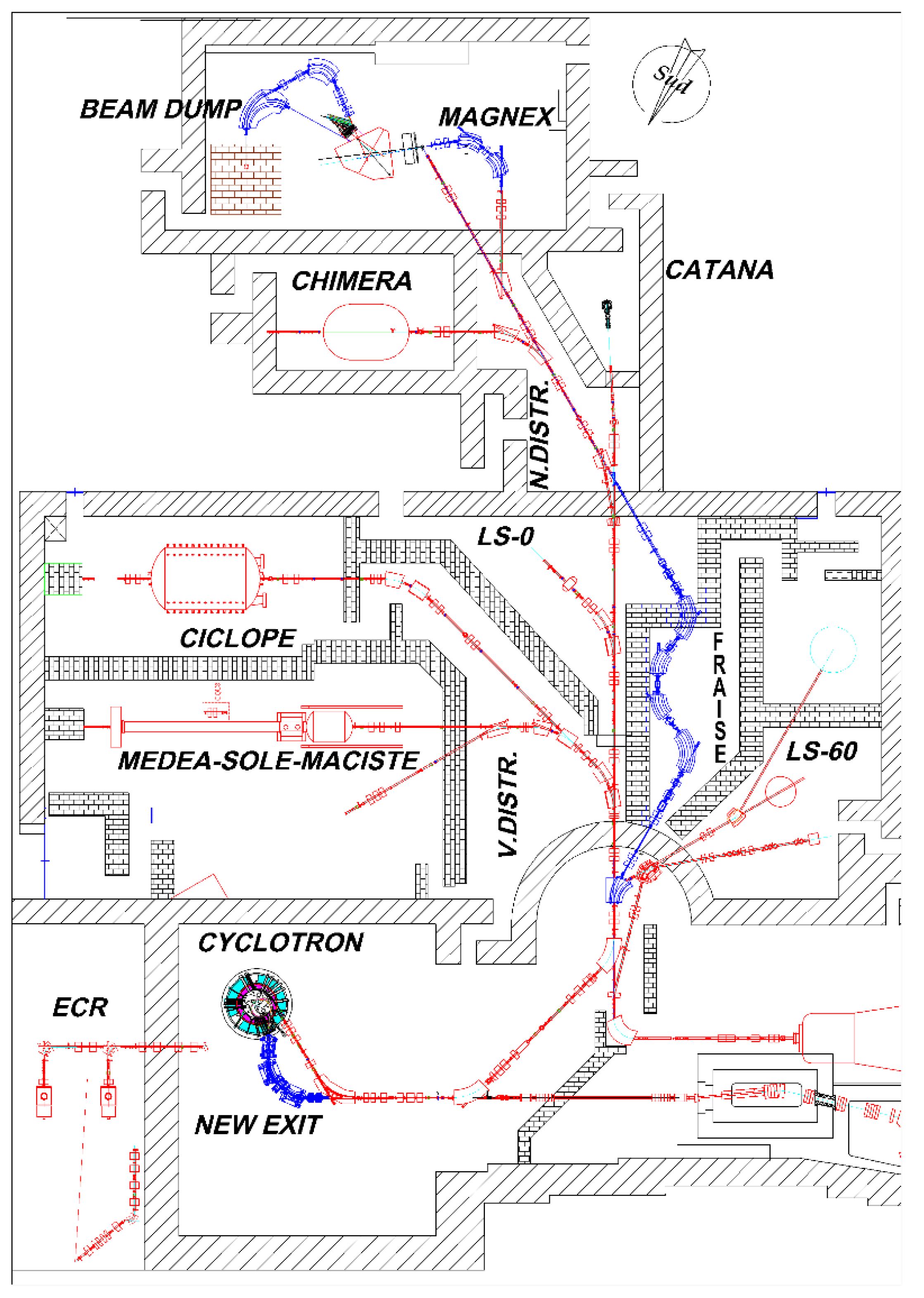
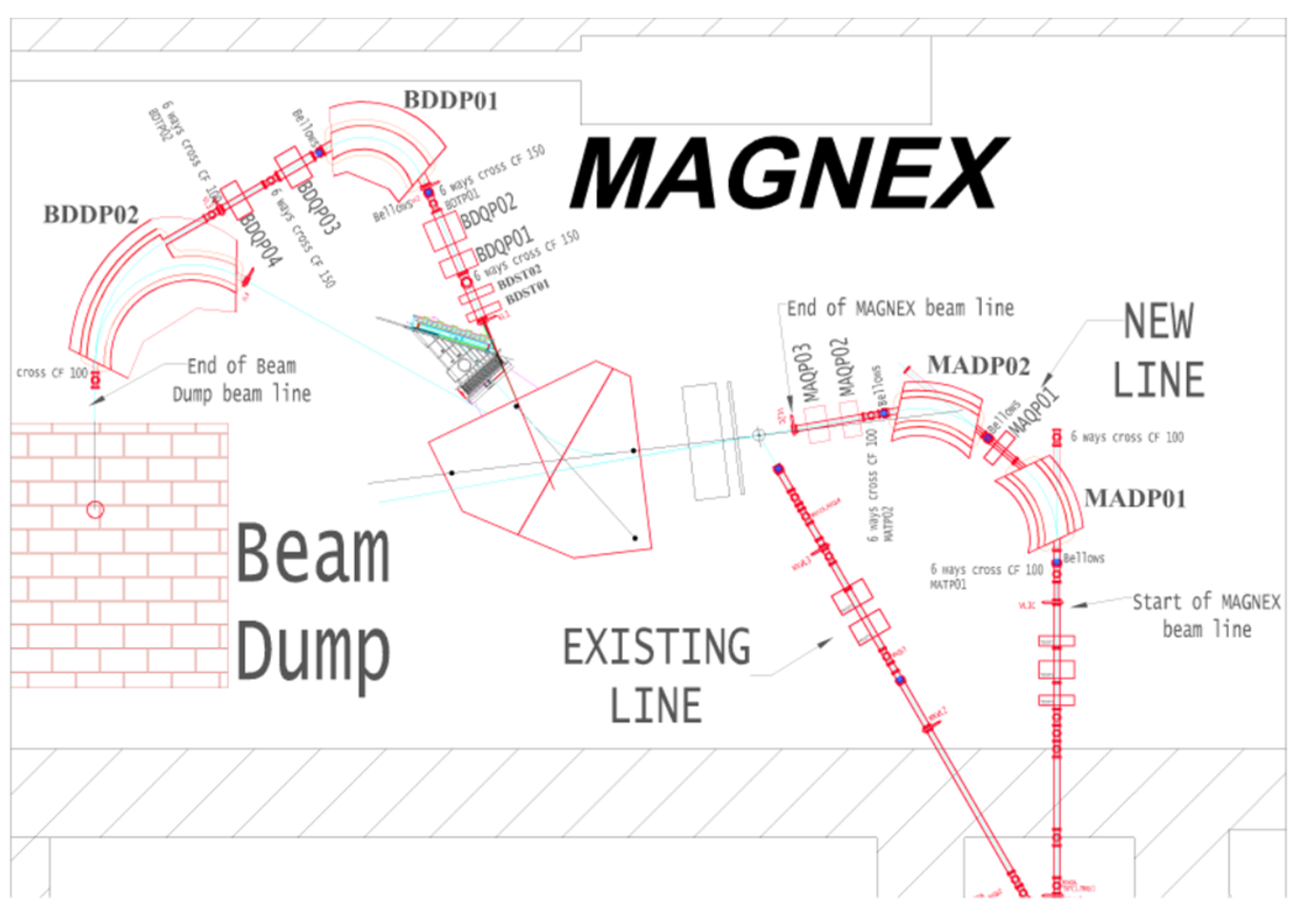
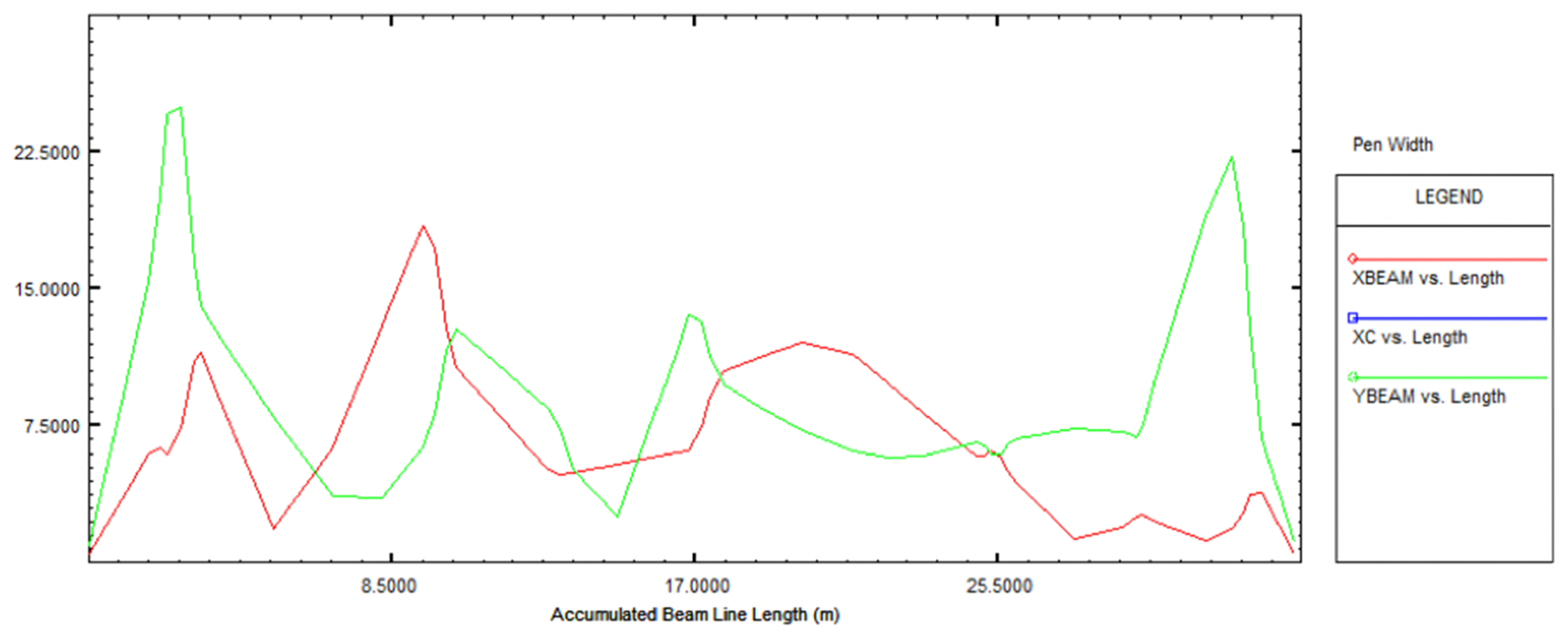
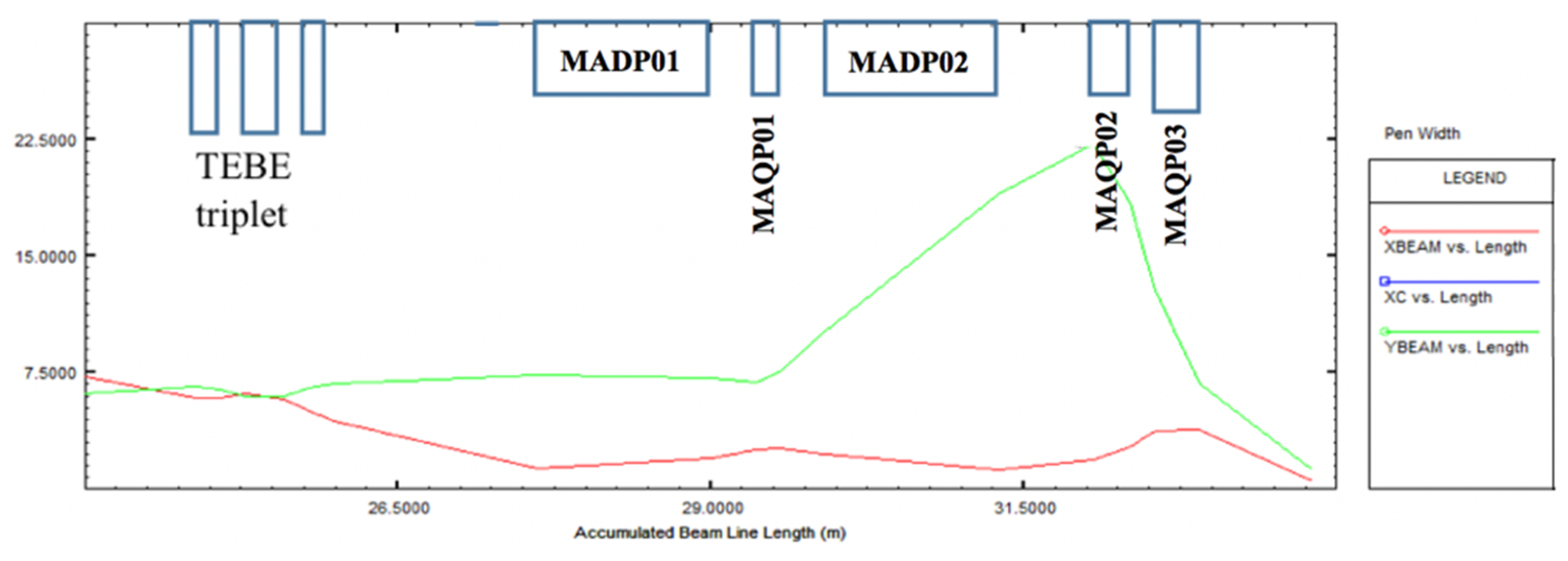
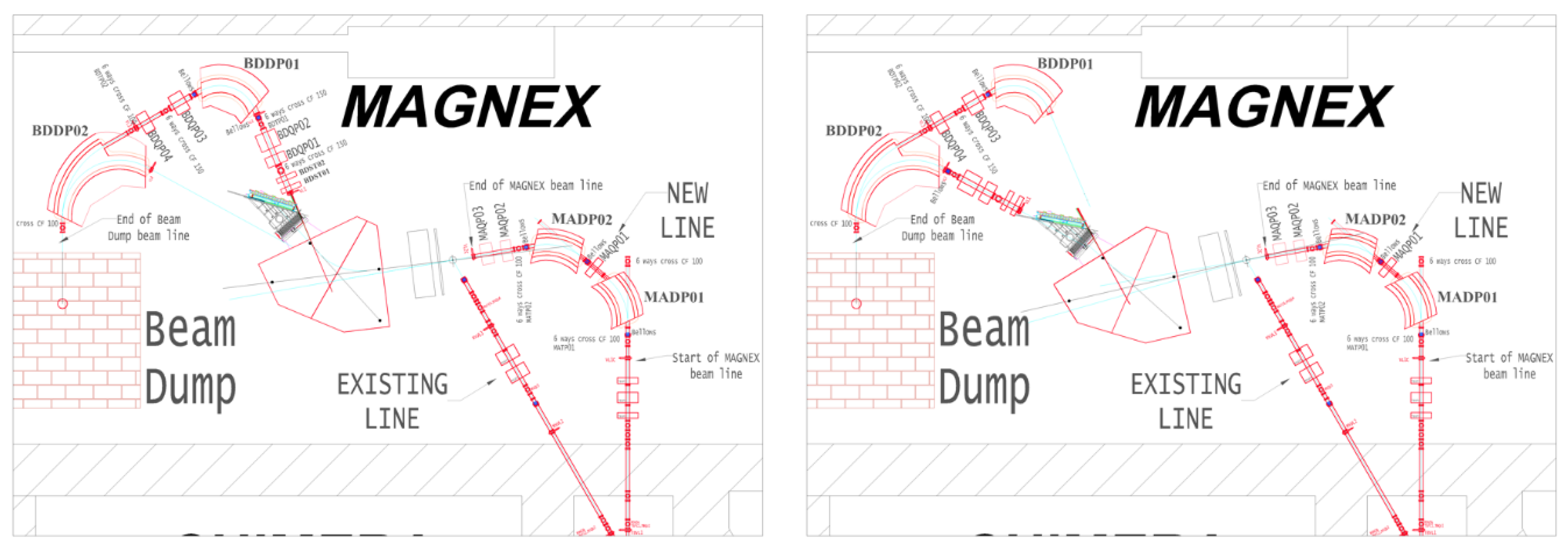
Publisher’s Note: MDPI stays neutral with regard to jurisdictional claims in published maps and institutional affiliations. |
© 2021 by the authors. Licensee MDPI, Basel, Switzerland. This article is an open access article distributed under the terms and conditions of the Creative Commons Attribution (CC BY) license (http://creativecommons.org/licenses/by/4.0/).
Share and Cite
Agodi, C.; Russo, A.D.; Calabretta, L.; D’Agostino, G.; Cappuzzello, F.; Cavallaro, M.; Carbone, D.; Finocchiaro, P.; Pandola, L.; Torresi, D.; et al. The NUMEN Project: Toward New Experiments with High-Intensity Beams. Universe 2021, 7, 72. https://doi.org/10.3390/universe7030072
Agodi C, Russo AD, Calabretta L, D’Agostino G, Cappuzzello F, Cavallaro M, Carbone D, Finocchiaro P, Pandola L, Torresi D, et al. The NUMEN Project: Toward New Experiments with High-Intensity Beams. Universe. 2021; 7(3):72. https://doi.org/10.3390/universe7030072
Chicago/Turabian StyleAgodi, Clementina, Antonio D. Russo, Luciano Calabretta, Grazia D’Agostino, Francesco Cappuzzello, Manuela Cavallaro, Diana Carbone, Paolo Finocchiaro, Luciano Pandola, Domenico Torresi, and et al. 2021. "The NUMEN Project: Toward New Experiments with High-Intensity Beams" Universe 7, no. 3: 72. https://doi.org/10.3390/universe7030072
APA StyleAgodi, C., Russo, A. D., Calabretta, L., D’Agostino, G., Cappuzzello, F., Cavallaro, M., Carbone, D., Finocchiaro, P., Pandola, L., Torresi, D., Calvo, D., Sartirana, D., Campajola, L., Capirossi, V., Iazzi, F., & Pinna, F., for the NUMEN Collaboration. (2021). The NUMEN Project: Toward New Experiments with High-Intensity Beams. Universe, 7(3), 72. https://doi.org/10.3390/universe7030072









